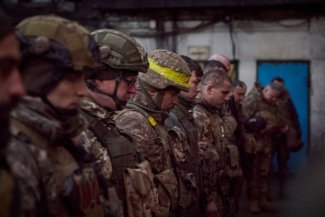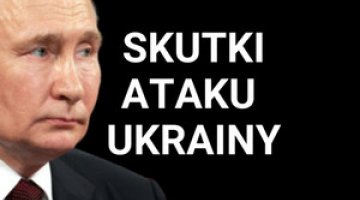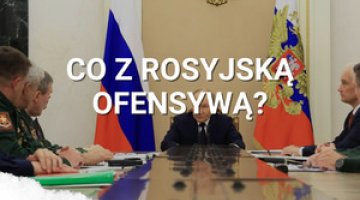Back to trench warfare. Day 495 of the war

At the beginning of July, the fighting in the Bakhmut area began to intensify again. Ukrainian forces renewed their attacks south-west of the town, and declared that they had made further advances towards the enemy-occupied town of Klishchiivka. Russian forces went on the offensive to the north-west of Bakhmut, striking at the Donets-Donbas canal between the M03 main road (Minkivka, Orikhovo-Vasylivka) and the north-eastern outskirts of Chasiv Yar. The invaders also made further attempts to push the defenders back from the western outskirts of Bakhmut; also, according to the Ukrainian General Staff, they renewed their attack on the western side of the Donetsk-Donbas canal, south-west of the town. The Russians also continued their offensive operations on the border of Kharkiv and Luhansk oblasts and south-west of Kreminna (albeit with less intensity than they had applied in the last ten days of June), as well as in the areas of Avdiivka and Marinka.
The Ukrainians renewed their attacks south-west of Velyka Novosilka, levelling out the front between Staromayorske (Donetsk oblast) and Pryyutne (Zaporizhzhia oblast). By contrast the Russian counter-attacks towards Rivnopil, which Ukrainian units occupied the previous week, appear to have failed. Successive attempts by Ukrainian forces to advance south of Orikhiv, towards the village of Robotyne and (for the first time) the village of Kopani, which lies to the west of it, and to capture the village of Piatykhatky (25 km west of Orikhiv), failed to yield significant results. On 1 July, the Russians eliminated the Ukrainian bridgehead at the mouth of the Antonivsky Bridge on the left bank of the Dnieper, but failed to drive Ukrainian sabotage and reconnaissance groups off the surrounding islets or to take full control of the bridge mouth (due to the impact of the defenders’ artillery strikes from the higher, right bank). The Ukrainians attempted to rebuild the bridgehead over the following days, but the small landings they carried out were repulsed.
On 3 July, Ukrainian deputy defence minister Hanna Maliar summarised the achievements of the Ukrainian Armed Forces over the past week. In offensive operations in the south, they have occupied a further 28.4 km², bringing the area liberated since 4 June to 158.4 km². In turn, as part of the improvement of the tactical situation and levelling-out of the front line in the east (mainly in the area around Bakhmut), Ukrainian troops have captured an area of 9 km². On the same day, Maliar and the commander of the Land Forces, General Oleksandr Syrsky, stressed that both sides were seeking the initiative in the Bakhmut area: positions are changing hands up to twice a day, and Ukrainian progress is being slowed down by the enemy’s defences, which are organised into three lines of fortifications. According to General Syrsky, the threat of a Russian thrust towards Chasiv Yar has increased again. A day earlier Colonel Serhiy Cherevaty, the spokesman for the East Group of the Ukrainian army, reported that 23 clashes had taken place in the vicinity of Bakhmut over 24 hours, and that “the occupiers are putting up fierce resistance”. By comparison, there were only ten clashes along a much longer stretch of the frontline from Kupiansk to Lyman. In contrast, according to a spokesman for the Defence Forces of the Taurida Direction, 19 clashes took place as part of the Ukrainian offensive in the south of the country, and 15 in the area around Marinka.
On 3 July, Colonel Cherevaty presented data on the size of the invaders’ formations in the East Group of Forces’ zone of operation. In total, the Russians are estimated to have more than 180,000 troops in Kharkiv oblast, the western part of Luhansk oblast and the north-eastern part of Donetsk oblast. The largest grouping (more than 120,000 men) is operating in the Lyman-Kupiansk direction. On 30 June, the general reported that the enemy forces in the Bakhmut area number up to 50,000 troops, with over 300 tanks, 330 barrel artillery systems and 140 multiple rocket launchers. He also stated that there were no more Wagner troops in the Bakhmut area.
The Russians have concentrated their missile attacks on the immediate frontline. Their latest targets include Serhiivka, west of Kramatorsk (30 June); Komyshuvakha, south-east of Zaporizhzhia (2 July); the settlement of Kushuhum on its southern outskirts (3 July), again the outskirts of Kramatorsk and Pokrovsk in Donetsk oblast (3 July) and Avdiivka (on 4 July; seven missiles hit the town). According to Ukrainian sources, the Russians are using between 3 and 12 missiles a day (on 2 July, the Air Force Command claimed to have shot down three Kalibr cruise missiles). Further attacks using Shahed-136/131 kamikaze drones were launched on Kyiv (on the night of 2 July, the defenders announced that all eight drones had been neutralised, and any damage had been caused by falling debris), Kirovohrad and Khmelnytskyi oblasts (on the night of 3 July; 13 of the 17 attacking drones were shot down), and Sumy, Donetsk and Zaporizhzhia oblasts (on 3 July; the Ukrainians announced that they had destroyed 16 of 22 drones). The most serious losses occurred in the attack on Sumy, where the invaders used four kamikaze drones: three civilians were killed and 21 wounded, and the local SBU headquarters was also hit. There was a renewed increase in the intensity of Russian shelling of the right-bank part of Kherson oblast, where 400–500 enemy shells have been falling daily.
On 30 June, the Danish ministry of defence announced plans for a new military support package for Ukraine. It would be worth €170 million (1.3 billion kroner) and would include missiles for air defence systems, demining equipment and funding for the purchase of artillery munitions. A day later the Spanish prime minister Pedro Sánchez, who was visiting Kyiv, confirmed his government’s earlier announcements regarding the transfer to Ukraine of an additional four Leopard 2 tanks, as well as armoured personnel carriers and a mobile field hospital. Mon 3 July, in an interview with the Polish Rzeczpospolita daily, the German defence minister Boris Pistorius announced that Kyiv would receive dozens of Leopard 1A5s from Denmark and Germany over the coming weeks (in May, the Danish side announced its intention to deliver 80 of these tanks this year). Pistorius also called for the creation of a Leopard 2 tank service centre in Poland to be speeded up. After meeting the Polish defence minister Mariusz Blaszczak, he stated that negotiations on this subject would be concluded within 10 days.
On 2 July, an account belonging to Yevgeny Prigozhin on the Telegram messenger published a message stating that the recruitment of mercenaries for the Wagner Group had been suspended on Russian territory, due to its planned relocation to Belarus. As recently as 30 June, Belarusian president Alyaksandr Lukashenka confirmed that he was prepared to “invite, at their own expense,” Wagner troops to undertake the training of soldiers there. At the same time, he insisted that the group would not include any prisoners recruited by Prigozhin. On 3 July, photos appeared on Belarusian social media of a field camp (estimated at 298 tents) which is allegedly being prepared to receive the mercenaries. In turn, reports spread in the Russian media space that 950 Wagner troops and their families might be sent to Belarus. The head of the Ukrainian border service, Andriy Demchenko, said that so far they had not noted the arrival of any such groups on Belarusian territory.
On 3 July, the German Chancellor and the Ukrainian president Volodymyr Zelensky held a telephone conversation, in which the latter thanked the former’s government for its military support, in particular for strengthening Ukraine’s air defence and artillery. Scholz reaffirmed Germany’s continued and unwavering solidarity with Kyiv, and announced that Germany would continue to provide it with support (including militarily) in close cooperation with its European and international partners. The politicians spoke in favour of extending the UN-supervised grain agreement beyond 17 July. Reflecting on the conversation in a statement to the media, Zelensky added that issues related to future security guarantees for Ukraine were also discussed.
On 4 July, the chairman of the NATO Military Committee, Admiral Rob Bauer, stated that the issue of delivering fighter aircraft to Kyiv would not be resolved in the short term, and certainly not during the ongoing counter-offensive; he added that training pilots and technical personnel takes time. When asked whether Ukraine could win the war without F-16 fighter jets, he replied that it had an advantage because it had Western weapons systems, better training and, very importantly, “much higher morale and motivation”.
Also on 4 July, in an interview with CNN, Zelensky urged US president Joe Biden to decide immediately to invite Ukraine to join NATO. He stated that he was aware that gaining full membership of the Alliance could only happen after the war was over, but nevertheless pointed out that such a move would increase the motivation of Ukrainian soldiers.
Commentary
- During the last month of fighting, Ukrainian forces failed to reach the first line of enemy fortifications in the south. However they did make progress in the Velyka Novosilka area on the border of Donetsk and Zaporizhzhia oblasts, advancing up to 8 km into the occupied area and regaining control of seven villages (out of the eight which they had targeted; they had to withdraw from the town of Piatykhatky west of Orikhiv). Clashes are still ongoing in the so-called ‘cover zone’. However, along the main direction of the Ukrainian thrust south of Orikhiv, from where the shortest route to Melitopol and Berdiansk runs through Tokmak, Ukrainian troops failed to penetrate more than 1 km into the Russian-controlled area. The military operations have again entered the phase of trench warfare, with the Ukrainians attacking with smaller forces than they did in the first weeks of the offensive (with company tactical groups at most). Nonetheless, it must be assumed that they still believe they can reach the first line of the enemy’s defence and break through it with a massive attack using more of their reserves than before. If this strike is unsuccessful, Ukrainian activity will probably decrease after the NATO summit in Vilnius (11–12 July), and the defenders will begin preparations for a new attack.
- The increased Russian activity on the eastern section of the front (mainly in the area around Bakhmut) should not be seen as an attempt to go on the offensive. As has been the case since last December, this fits in with the same pattern of exploiting weaker spots in their opponents’ defence and gradually moving the front line. It is highly likely that the invaders are still afraid of incurring heavy equipment losses if they make a more serious attempt to break through the Ukrainian defence and build on their success by introducing armoured and mechanised groupings into the breach. Indeed, reports from the Ukrainian side indicate that the invaders have a grouping at their disposal that would allow them to take offensive action on a much larger scale than at present.
- It is still unconfirmed whether the Wagner troops have arrived in Belarus. However, it is very likely that this will happen once the parties have agreed on the conditions of their stay and how they will be further funded. Sensitive issues for Lukashenko are the retention of control over the mercenaries and the possibility that they could, for example, be used for sabotage or to support Belarusian activity in Africa. If Prigozhin retained his independence to decide further courses of action, that would violate Lukashenko’s monopoly on managing Belarus’s domestic security policy. Nor does he want to maintain the Wagner forces at his own expense: he is probably counting on a favourable proposal from Prigozhin. However, if the funding from Russia is cut off, Prigozhin is unlikely to be able to maintain a military force numbering many thousands for any length of time.





